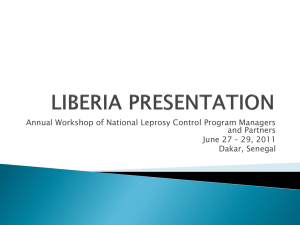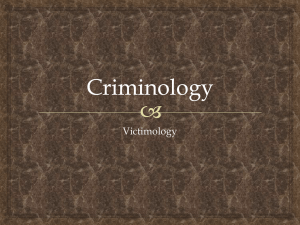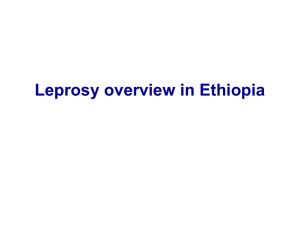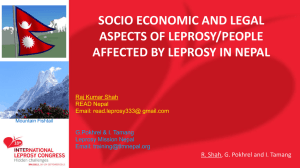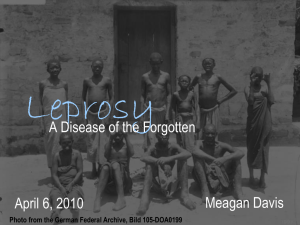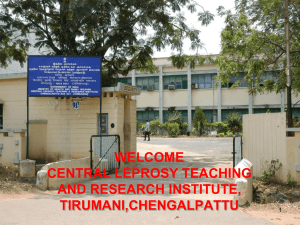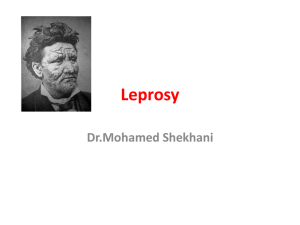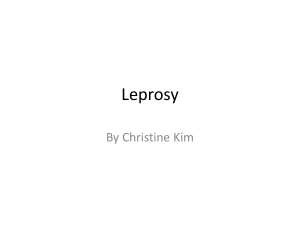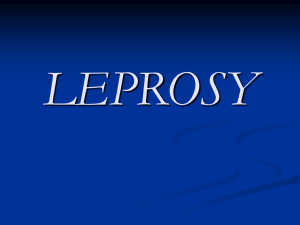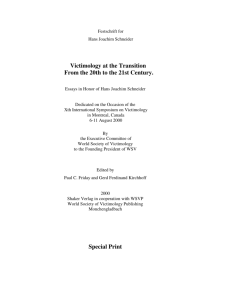Hansen`s Disease presentation
advertisement
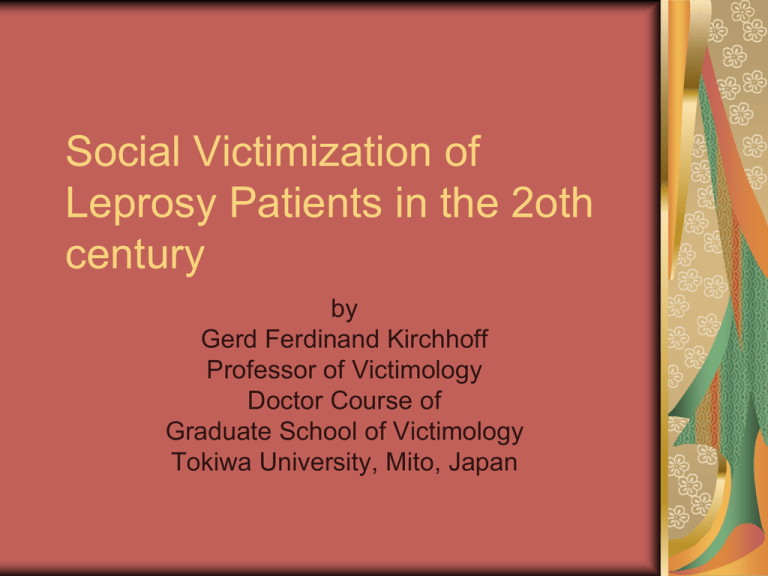
Social Victimization of Leprosy Patients in the 2oth century by Gerd Ferdinand Kirchhoff Professor of Victimology Doctor Course of Graduate School of Victimology Tokiwa University, Mito, Japan Leprosy was perceived as a grave threat for human health and for the human community in general. Leprosy control laws are not a standalone isolated phenomenon. There are four different ideologies which I want to look at when I try to explain these control instruments. Idelogies discussed in this paper 1. an applied Darwinist evolutionary orientation in the emerging social sciences. 2. new theories in medicine about diseases (mainly cell pathology and immunology bit social medicine as well) 3. the ideology of eugenics and racial health preservation 4. a growing insecurity in the law community These ideas greatly upset the traditional legal justification of punishment and social control. In the wake of the resulting policies, several ten thousands of infected patients in Japan were forcefully separated from their families. They were arrested, and banned from their communities. They were committed to leprosaria where the were to stay until they died. In this presentation, I will deal with some underlying ideologies that led to mass victimizations in the Japanese Leprosy Control system. Leprosy - later called Hansen’s Disease - was the curse of mankind for centuries. It was regarded a very dangerous disease that was spread through contacts with lepers. It is caused by a bacterium Mycobacterium leprae. The infection causes damage to the skin and to the peripheral nervous system. The disease develops very slowly (from six months to 40 years). It results in skin lesions and deformities. It most often affects the cooler places of the body (e.g. nose, eyes, earlobes, hands, feet, testicles). Left untreated, it can cause disfiguring damages. In 1873, the Norwegian physician Hansen discovered bacteria in leprosy lesions, suggesting that the disease spread by infections. It was not a hereditary disease, as Hansen’s father-in-law, a famous Norwegian physician and director of the central leprosy hospital in Norway, believed and propagated. Buddhist monks in Japan taught : it was a punishment for sins committed in a previous life. The hereditary school drew from the observation that often the disease occurred among members of the same family. There was no cure, no therapy. For more than 5 000 year, humans reacted with contact avoidance and prohibitions, with exclusion, with enforced exiles and isolation. Lepers had to live outside human settlements. See the former leper “holes” in the old Dubrovnik Special clothes Rattling acoustic warnings (rattles, bells) Many infected became homeless - in Japan often the shrines were the only places where they lived as beggars until they died. Victimology of Hansen’s Disease Control Definition of victimology Social science of victims, victimizations and the reactions to both Analysis approach from various sides Individual side: victimizations as invasions into the self of the victim, causing damages, distress, crisis and crisis reactions, demanding crisis intervention and assistance in coping when necessary. Looking at the sufferings of the leprosy patients. Can be originated by the invasion itself (infection?) or by damaging reactions of the social environment. We do no look at the damages produced by the bacterium itself (victimology is not medicine). It is not concerned with victims of bacteria or viruses. The “fallacy” of General Victimology Victimization by reactions towards the patients The families who disowned them The neighbors who denunciated them and avoided them The village, the schools who expelled them The agencies of health control who placed them into closed institutions Theoretical problem: do we have here a secondary victimization without primary victimization? That would not make sense. Health politicians created the laws that prescribed compulsory confinement in leprosaria. These laws created an immediate danger of law enforcement that would victimize. Victimizations are Imprisonment Arrest Forceful separation from home and family Family members blowing the whistle denunciating their children Schools excluding infected people Often compensation in these cases is denied with the justification that “the law of the land” permitted these measures. Victimizations happen in a broader social climate. The patients in Japan were treated in a horrifying way: they were forcefully separated from their families, from all their resources, they had to leave their property behind, they were forcefully transported, injured, and were banned and exiled into closed institutions until they died. This is what happened with patients of HD. The first part in victimological analysis is to answer: “What did did they suffer?” That is a shocking part. Victimologists try to stand in the shoes of the victims, they try to do “victims victimology” (SBD 2000). That is a scary and frustrating and depressing stage. Victimology is a sad science if we stay and if we remain here. Some do. We as scientists have to continue, we cannot be content with compassion (sic) alone. “Why did they suffer” is the next question. What are possible explanations that make clear why this victimization happened to them. There are different method of accessing the answer to this question: Historical access Medical access Sociological access Psychological access Social work access The more accesses we activate the more chances do we have to understand better what happened to the victims. Then the shocking depressing phase is past. This is the phase of understanding, a very rewarding phase. The next phase is: what has to be done to alleviate the burden of the victims? What kind of assistance is needed? How to get restitution” compensation? How can we prevent that such victimizations happen again? That is the richest phase of victimological analysis - it looks into the future. Here is the place for Natti Ronnell’s Positive Victimology. That allows me to distinguish different elements in the construction. E.g. Dubrovnik centuries of coexistence between Serbs and Croats - reality was constructed to call for coexistence. If this construction is given up in favor of calls for ethnic cleansing, then sooner or later ethnic cleansing become reality. Convictions either favor or they impede victimizations. e.g. power disequilibrium between men and women, support of unequal power favors victimization. If a disease is defined as consequences of sins in previous lives, it shifts the burden to the patients. It is pretty irrational and you have to believe a lot of things before you can understand this construction of reality. But people construct this way. If an incurable disease is defined as extremely contagious, then victimization of the patients is very likely. However, if the disease is defined differently, victimization is less likely. The definition of victimization is already framed and molded by ideology. That is obvious in case of victimization by weapons of mass destruction in WW II in Germany and in Japan. It is not only the damage, victimization needs social recognition - otherwise it does not exist. Child beating in family and in schools Corporal punishment in schools Victimizations during trainings in high performance sports Silenced conditions in institutions of aging and dying (we instantly and quasi religious hope that physicians do not abuse their power) Female genital mutilation, Circumcision of boys. Wife beating in India and Arab countries Kurds as victims of mass persecutions (chemical weapons) during Saddam Hussein’s regime (no compensation) Victims of Human Trafficking - who is the victim? Who deserves assistance, protection and treatment? Who is target of repressive social control? The social climate is molded and constructed by ideologies. Ideologies are the set of general or abstract beliefs or assumptions about he correct, proper and desirable state of things, particular with respect to the morale and political arrangements which serve to shape one’s own position (Miller 1973 p.2).Ideological positions are often preconscious rather than explicit, and they serve - under most conditions - as unexamined presumption that underlie positions taken openly. They bear a strong emotional charge. This charge becomes evident when the ideology is challenged. Scientific positions are very often based on ideologies. Ideologies in law and politics , economics, psychology and criminology. Miller: ”In crime and crime control, it is all about ideology”. Once established, ideologies become relatively impervious to change since they serve to reject or receive new evidence in terms of a self contained and self reinforcing system. They support the ruling systems and the ruling institutions. By this, they become part of the definitions that favor victimizations and that impede victimizations. When science deals with social problems, we see how generally shared beliefs determine how facts are constructed. What is accepted as fact? Scientific convictions are nothing but a special construction of reality (Kuhn 1968). If the constructions change, scientific convictions change as well. If society reconstructs a disease as deadly contagious, it will develop different consequences than if science constructs the disease as containable, curable and only mildly contagious. Exactly that happened with the social responses to leprosy worldwide and in Japan. Examples: Victimologists do not like to look at victimizations in prison conditions in Guantanamo must be brought to our attention by hunger strikes. Victimologists do not look at executions of death penalty they do not even comment on the new government of Abe being responsible for 5 state sanctioned killings. For some people, even death penalty is not enough - ritually the mass media report about opinion polls that favor to 85% death penalty, if not “something worse”. Definitions of reality influence the perception of victimization. Reality is not something that exists outside our definitions. This thesis is grounded in the small and harmless looking sentence of William I. Thomas and Dorothy Swaine Thomas, The Child in America, 1928 p.573: “If men define situations as real, they are real in their consequences”. It became the credo of the upcoming science sociology, and, elaborated by many great sociologists, the term “Social Construction of Reality” became an acknowledged technical term. This explains THAT definitions are so powerful. But how do they become so powerful? Lessons from the Sociology of Social Movements Social movements (Mauss 1975) start in a small circle of concerned often dedicated and passionate people. Growth of the movement. Research in Tokiwa has used this approach to interpret the victim movement (Kirchhoff 1998, Kirchhoff-Morosawa 2012, Okamura 2012). Public 1: The Internationale Kriminalwissenschaftliche Vereinigung Consisted of concerned experts that saw that the predominant ideology that justified punishment, was eroding. It was the absolute guilt -theory in the wake of Kant and Hegel: Retribution was seen as the only valid justification of punishment. This ideology effectively blocked away any discussion about alternative purposes of punishing (like resocialisation or general and special prevention). Two very disquieting trends were felt by the lawyers. With the rise of natural sciences in chemistry, physics, astronomy, medicine and with the invasion of natural science methods into the upcoming social sciences, the absolute theory became target of attack. Soon it was ridiculed and branded as hopelessly antiquated. The industrialization changed the focal concerns: masses of uneducated workers concerned the ruling classes - their health status was dangerous and their educational level needed improvement. In Japan and in Germany, the general draft systems and the obligatory school system were introduced, and that made medical control of the whole nation - in Japan and in Germany - necessary. Medicine and social health politics became the dominant topics. In 1906, the IKV had 1347 personal members from 29 countries. 77% were lawyers. The next biggest group with 4% were physicians. Despite all programmatic references to include anthropological, medical and sociological research, the IKV was an almost pure association of lawyers. The almost undisputed authority in this field was Franz von Liszt. The lawyers took notice of what happened in medicine and especially in social medicine. Maybe it is too polemic but the impression prevails that no longer the lawyers as interpreters of the interests of the powerful classes were most important for the wellbeing of society. They were extremely impressed by the progresses of medicine and they tried to integrate the principles developed in medicine to social control via criminal law. Rudolf Virchow 1821-1902 An ardent democrat, Virchow was not only founder of cell pathology but founder of social medicine as well. In a path breaking report on the outbreak of typhus in Silesia ( an epidemic that closed the very important coal mining facilities of the region) he wrote 1848: The outbreak could not have been solved by treating individual patients with drugs of with minor changes in food, housing and clothing laws but only though a radical action to promote the advancement of the entire population which could only be achieved through full and unlimited democracy, education, freedom and prosperity. Virchow on social problems “Medicine is a social science, and politics is nothing else than medicine on a large scale. Medicine, as a social science, as the science of human beings, has the obligation to point out problems and attempt their theoretical solution: the politician, the practical anthropologist, must find the means for their actual solution. The physicians are the natural attorneys of the poor, and social problems fall to a large extend within their jurisdiction”. 1874-1884 he conducted the most elaborative comprehensive anthropometric project in the German Empire, 6.8 million school children were surveyed (anthropological measurements). To create good health conditions for the masses of industrial workers and good education to meet the demands of the army and industry became a central topic, not only in Germany but in Japan as well. The social prestige of physicians grew immensely – they were a living proof for the success of the new states – the new Germany and the new Japan. Robert Koch 1843 - 1910 The leading immunologist, worked on anthrax and on tuberculosis (Nobel Price in 1905). His students found the organisms responsible for infectious diseases like diphtheria, typhoid, pneumonia, gonorrhea, cerebrospinal meningitis, leprosy, the bubonic plague (this was done by his important Japanese disciple Shibasaburo Kitasato 1894), tetanus and syphilis (Wassermann). Between 1896 and 1907, Koch spent 10 years worldwide teaching and travelling, six in Africa and the remaining 4 in Asia and India. A private trip brought him 1908 to USA and Japan (visit to his disciple Kitasato - Director of the Japanese Institute for Immunology, the nucleus of Kitasato University, and later Dean of Medical School of Keio University, first president of the Japanese Medical Association , member of the House of Peers). Nobel Price in Medicine in 1905. Cell pathology (Virchow) and immunology (Koch) are the two medical schools that fascinate the thinking of the time. The political task of medicine was obvious: The creation and maintenance of a healthy population was decisive for a successful industrialization and a blooming industry. Both depend on a good school system and on the military strength of a country. Till the middle of the century, the lawyers had been the ones who were directly useful for the ruling classes in the feudal order - but that monopoly changed. The new theories in medicine Combined with the evolution theory of Darwin These developments led to an insecurity of the law professors and the leading figures in the political sphere. This insecurity lead the traditionalists to a procrastinated absolute guilt theory (following the Retribution Thesis that was attributed to Kant). More progressive ones looked for an alternative. The leading figure in Europe’s criminal law was Franz Ritter von Liszt (1851-1919). Franz Ritter von Liszt (1851 1919) was a German jurist, criminologist and international law reformer. As a legal scholar, he was a proponent of the modern sociological and historical school of law. He was President of the IKV. In his Petersburg lecture 1902,he proclaims: Criminal law has to protect the weaker as long as possible so that they do not loose in the fight for survival of the fittest. Where such assistance is no longer possible, the legilator has to take care, that those elements are eliminated that are completely unsuited for coexistence in society. While it is obvious that society itself performs this elimination: the misfits will go down without fail, afetr one or two generationstheir ability to reproduce is exhausted. But this social selection process is very slow and it is connected with severe victimizations for society. The wellbeing of the whole and the care for the individual demands imperatively the intervention of the state. Without any softness but without unneccessary strictness the legislator has to perform the elimination. This speech reflects the predominant ideology. It reflects what was taught and learned in university seminars. Ideas are somehow connected with the concept of race. A subfield of Eugenics that looked at the physiologically and genetically determined differences of nations. In the context of colonialism, the concept of race was used to degrade groups like Indians and Jews. “We take animals as they are and we treat them accordingly. In the same way, unbiased and unprejudiced, we should treat humans as well” (Moebius 1853 - 1907) Ueber Entartung 1900 p.120). A great deal of teaching and publication was spent on efforts to find ways to preserve the purity of the race and to find social institutions that serve the purpose to avert deleterious consequences for the “healthy body of the race”. One of the lawyers, fascinated by the promise of medicine, studied medicine in Paris and became later the founding father of victimology. Hans von Hentig: Strafrecht und Auslese 1914 p.85: “We have to get used to the idea that some criminals are not improvable. It would be irrational to help where any help is futile. If we want to argue for real empathy with these unfortunate individuals, then we cannot do a better thing than bye and bye to let this class of humans gradually die out.” Social Darwinism at that time gained currency with scientists around the world, so in Japan. Eugenics - so the Japanese Hisomu Nagai - involves the prevention of sexual reproduction through induced abortions or sterilization among people deemed unfit . And unfit included for him Alcoholics Lepers Mentally ill Physically disabled Criminals The Leprosy Control Law of 1909 Provided that all leprosy patients should be interned in leprosaria. Coupled with an extensive propaganda campaign “Our Prefecture is leprosy-free” The law was enforced: Patients were collected in schools, at the workplace, from waiting rooms of physicians clinic, Married partners were forcefully separated, children separated from their parents. One women Onose-san interviewed had already three children and was pregnant when diagnosed to suffer from leprosy. Her mother had forced her to an abortion. She secretly was brought at night to the leprosarium so that neighbors did not realize that family was hit by the shameful disease. Families were afraid of discriminating reactions of the neighborhood Patients were hidden from sight of the neighbors as long as possible Either neighbors blew the whistle and police arrested the patients or the health officer informed police. Physicians had to inform the authorities of cases of leprosy. In another case Onose-san interviewed, a brother developed leprosy while in the army - that led to discovery of a sister being infected at home. Patients were usually disowned by their family who feared the social exclusion and ostracism of the community. They feared that somehow patients would come back and bring dishonor to the families. Still today patients do not return to their place of birth since they fear to bring shame and dishonor to the family members who still reside there. Onose-san interviewed a 83 year old patient. Her husband divorced her 5 years after institutionalization. He never mentioned her to anybody nor did he ever write to her. She was silenced and did no longer exist She wanted to know about the live of her three children, never dared to ask. The leprosaria were closed institutions - no one could leave them. Upon commitment, patients had to sign a form consenting to their autopsy - that caused considerable fear and confusion, of course patients hoed to be cured. Institutions were badly financed and had to be self supporting, few physicians and nurses, untrained supervising personnel. Patients had to do all work, cook meals, provide farming, provide wood for heating in winter, clean rooms, had to do all construction works - that was dangerous since the disease brought numbness of the limbs (severe wounds) In institutions, strict separation of men and women. Heavy punishment for those who violated this order: Forced sterilizations, forced abortions. “It is a lovely baby and it looks like you!” The presentation of the fetus after abortion was routine, anesthesia were believed to be a waste of money. These stories were mentioned to Onose-san and that shows how traumatic these events were. Punishments made the regime even more unbearable. Escaped patients were retransferred Kensuke Matsuda wrote that patients committed assault and battery, theft, adultery and riots - directors had not been given authority to police or to punish patients. Normalprisons would not accept lepers. A special leprosy prison was built 1953 - but since 1916 the government empowered directors to punish disobedient patients. They could imprison patients up to one month, reduce their food. Directors regarded this as a mild form of house arrest. These arrests would have rarely any effect on the “brutal one’s” who would repeat crimes. Directors decided to build a special facility. Praised by practitioners, the new institution was a cruel place of disease and death - debilities, pneumonia, nephritis and suicide - outside temperatures dropped to minus 16 degrees C, there was no heating. The time of imprisonment exceeded maximum permitted lengths - one prisoner survived for 500 days. Forced sterilizations on absconders, patients who wanted to cohabitate were given the permission provided they were sterilized. This was seen as the milder and more effective way of controlling behavior of the inmates (compared to punishment and gender separation). It served peace and tranquility in the institutions since no new children were born. The leprosaria were not small institutions: 1900 30 000 patients were found in Japan. 1955 11 057 Inmates 1955 the directors of the institutions demanded from parliament to maintain and enlarge the capacity - that happened in spite of the fact that since 1943, with PROMIN 1943 there was a effective medicine. But the effect was not perfect, relapses occurred, in addition Promin was very painful to administer. Therefore the involved physicians convinced parliament that the disease was still very contagious and incurable. In 1950 and 1951 the three directors led by Kensuke Mitsuda stated that about 9 000 patients were institutionalized and 6 000 still were outside the institutions. In 1951 already, one director explained to the parliament that many deformed patients could not be released from the institutions since they remained unaccepted in society and therefore could not live outside. The Leprosy Prevention Law from 1953 basically restates the prohibition to live outside the institutions and the prohibition to leave these places. Counter Actions With the new constitution providing for individual rights, the Patients’ Federation became more and more active as a public opposing official policy. They insisted that the institutions lacked the scientific basis and that they violated human rights. They claimed to be victims of enforced segregation and of a social stigma that was created and maintained by the law.. 1973: the federation filed a petition for a revised law and sends 200 patients to pressure parliament and ministry. Ministry argues: the existing law legitimizes compulsory isolation of patients and it constitutes the legal base for government’s responsibility to provide the inmates with care and comfortable living environment. Revision of the law might abolish the leprosaria, patients could no longer live on public support. In a survey after that only 16% of the inmates voted for being discharged. The rest felt they were unable to live without leprosaria. That is no surprise: the leprosaria existed for more than fifty years, patients were really dependent on them. They were afraid to be forced to leave the institutions they were forced to get accustomed to. 1976: the directors draft a law that incorporated specific discharge conditions - rejected by the patients federation - this could end up in enforced discharges. The Federation feared that budgetary considerations would play the main role, not their welfare. In 1998, the Kumamoto Court ordered several million Yen compensation to 127 patients for their illegal internment. Prime Minister Koizumi prohibited an appeal of the sentence. 2009: 2600 leprosy patients live in 13 national sanatoriums and in two private hospitals. Their mean age is 80 years. There are no newly diagnosed leprosy patients in 2005 in Japan, in the following 2 years one per year. Due to age, sterilization and abortion, the patients do not have children. Many have diseases of advanced age, and help is necessary. Some earnestly hope for social rehabilitation, but there are very few who are active in society. Those in sanatoriums, enjoy the help and he care of physicians, nurses, health workers. Some families visit them in the sanatoria and some visit their families. a high The literature I consulted, blames the government or keeping the institutions even if there was medical help available. The reason behind this delayed reaction is that many persons are involved in maintaining such a system and these people do not want to admit that their work over the last fifty years was a mistake. These people had invested considerable time and work. They simply did not want to give up. Shortly before the Kumamoto sentence, the physicians working in the leprosaria were celebrated in a parliamentary discussion and the leading director was awarded a high decoration – with this the old generation was given the chance for a honorable farewell. The surviving patients were compensated. The institutions were transformed into sanatoria or in homes for the aged. Outlook All in all, leprosy is no longer a problem in Japan. The number of former inmates will decrease drastically and finally no one will survive. But that is no longer a problem of victimology. The compensation measures have been reported as generous and satisfactory. The survivors can expect to end their lives in security and being cared for. Survivors are active in informing the public about the history of their suffering. A Hansen’s Disease Museum in Tokyo keeps alive the memory and collects all publications about the Leprosy Control measures in the past.
